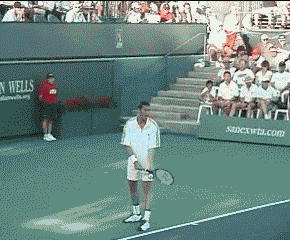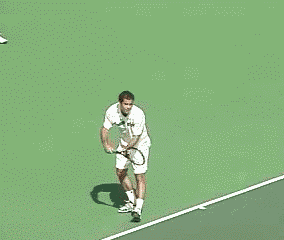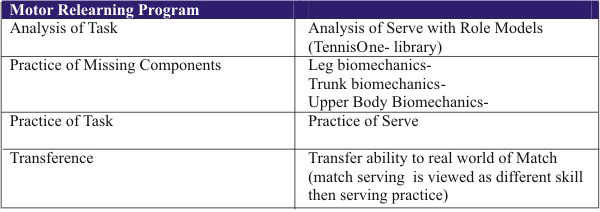|
TennisOne Lessons The Serve - Do You Throw Like a Girl? Ian Barstow Not to long ago I watched Alicia Molik during a match ask a ball boy for a ball and then throw it to the diagonally opposite corner of the court. This excellent throw reminded me of Richard William’s proclamation. “Girls can not throw and this is why they can not serve.” Well obviously Alicia Molik can throw and maybe this is why she has a great serve. I also know that Sir Richard had trained Serena and Venus to throw tennis racquets over the back fence to teach them how to serve. Venus' serve is now officially the fastest ever at over 130 mph and it appears there could be a correlation between throwing and serving. Most of us would love to throw our racquet into the ball like she does. So, when you think about it, throwing like a girl can be a good thing if that girl happens to be Alicia Molik or Venus Williams. (Check out Venus' stats below compared to Rafael Nadal at the Wimbledon finals).
Strength vs Coordination On the tennis circuit I have heard many theories about the difference between men’s and women’s serves. By figuring out the differences we can focus our time on working on the solutions. Many people will say that Alicia, Venus, and Serena are the exceptions – just look at their great physical attributes. They are bigger, stronger, and faster in delivery than most of the other girls. Coaches will say it is all about strength and these girls are phenomenally strong. If this is the difference the solution is to hit the gym (nothing we can do about genetics). Well these girls are superwomen but to throw a spanner in the works, I'd like to show those coaches a party trick – my ability to throw a ball with my left and right hand. The distance made by my right (dominant) hand always doubles the left (non dominant) hand. Most of the coaches are quite dumbfounded by my party trick and many of them tell me that when I throw with my left hand “I look like a girl.” The goal of this trick is not to show that we all throw like girls with our off hand, but that the difference has little to do with strength. I am almost equal in strength on both sides from working out at the gym (my dumbbell presses are exactly the same in all planes) and studies show most people have only about 5-10% difference in strength between their dominant and non dominant hands. So clearly then this does not explain the huge disparity in throws between my right and left hands. So why am I throwing like a girl? The truth is the power of our throws has a little to do with strength and much to do with the ability to use the kinetic chain in a co-coordinated fashion. Many throwers are unco and many of our serves are not as coordinated as we think. Since the biomechanics are so similar, I often use throwing to illustrate the ability to use the kinetic chain from one side of the body to the other, and to assess serving ability. So, how is your throwing ability? If I assess that a player is not a good thrower, then as Richard Williams suggested, if the player learns to throw better the player will serve better. It certainly seemed to work for the Williams sisters. Learning to fire the kinetic chain in a co-coordinated way through throwing will dramatically improve power and may just teach you how to use the kinetic chain to serve better. Throwing is one of the off court tricks that many players use to improve the performance of their serves. It seems to be particularly popular with girls and I have watched Maria Sharapova throwing many times during her warm ups. The Stretch Shortening Cycle – Living Rubber Bands When you start researching throwing mechanics you will learn it is about using the whole kinetic chain and the stretch shortening cycle. The stretch shortening cycle is a way to dramatically enhance your power. The stretch shortening cycle is made up of the stretch reflex and the serial elastic component. The serial elastic component is a consequence of the muscles, tendon, and connective tissue storing energy like a rubber band when stretched and releasing that energy when shortened. The stretch reflex is what happens to the body when a quick stretch is put on a muscle like when a doctor taps the quadriceps tendon. The tap on the patella tendon cause a quick lengthening of the quadriceps muscle which reflexly causes the quadriceps to contract. The combination of these two events leads to about a 20%- 50% increase in power and is used in every shot we make. Some of us have learned to use it much more effectively then others. Heath Waters has shown the pro’s using this phenomenon very nicely in the wrist in the modern forehand and pectoralis muscles on the serve.
There are growing number of coaches and trainers talking about the muscles as if they were elastic bands. I like to think of the muscles more like live rubber bands and the live part is the muscle that responds to the quick stretch. The quickness of the stretch will determine to a large degree the total amount of stretch. For example many people are using this phenomenon in the gym with exercises such as the bench press. People performing the bench press will “bounce” the weight off their chest. In doing so they are eliciting the stretch reflex of the pectoralis muscles. Studies have shown when you remove the bounce by pausing slightly, you decrease strength by 55 percent. Try it and you will see that using the stretch shortening cycle gives you a biomechanical advantage. So when serving it is important not to have long pauses in the service motion as this decreases subsequent power.
These quick stretches are the result of co-coordinated sequencing of the segments of the body. Since the mechanics in serving and throwing a ball are very similar it would appear that we could use throwing drills that have already been designed to address these physical challenges.By transferring this knowledge into the technical training of the serve it can help unleash a significant amount of power. Specificity Training As always we use visual role models from TennisOne video library to help Melinda develop her technique and make training specific to tennis. For the leg drive we use Marat Safin who has a similar slide up position to Melinda's. For rotation we visualize Serena Williams and for pronation we visualize Pete Sampras.
The concept of specificity of training should never be forgotten. We know the closer the drill is to the desired action the more transference we will get. A lot of my understanding of this comes from studying physical therapists Shepherd and Carr’s Motor Relearning Program. These Australian researchers are leaders in the world in skill acquisition and basically teach a very simple way of motor learning that may benefit you (see below).
Like all good physical therapy analyses we are going to start from the ground up.
Throwing Drills Instead of performing baseball pitching drills it makes sense to make the throwing drills more specific to your tennis game. In the following drills you will see how I have used the concepts in this article to develop a tennis specific throwing program for Melinda Czink. The key for a coach or player is to understand kinetic chain and stretch shortening cycle concepts and then use this new knowledge to enhance the performance of the player’s serve. Drill 1: Leg Drive In this drill we are trying to facilitate the use of the triple extensors of the lower extremity (triceps surae, quads/hams, gluteals) to load the arm to throw the ball. Melinda is throwing from the exact same position that she will serve from. Melinda slides up, however, if you do not slide up then start from the stationary position you serve from. The goal is for her to drive up and into the court with her legs and then channel the energy from her legs into her throwing arm. The better her leg drive the more potential power she should have in her throwing arm.
A lot has to do with timing and learning to co-ordinate the kinetic chain. Just watch a baseball pitcher’s leg drive and you will get some idea of how much of his power comes from the ground up. Remember to try to facilitate the stretch shortening cycle by quickly stretching the calf, quads and gluteal muscles. Drill 2: Open Stance In this drill we are trying to facilitate the use of the oblique muscles to load the arm to throw the ball. Rotation is a critical aspect of the serve and experts feel many players could gain 5-10 miles per hour if they improved their rotation. Here you can begin to see how much a player rotates. A simple visual is to see where the throwing elbow faces in the loading phase. The more rotation the more power you will see in the throw. Again you want to get a quick stretch on the obliques by leading the throw through the dominant hip. As the server learns to quickly fire the core muscles he will elicit the stretch reflex and you should see even more power. Often with more power there is a loss of accuracy of the throw as one must learn to co-ordinate more moving parts in the kinetic chain. Drill 3: Pronation (internal rotation)
In this drill you want to facilitate the use of pectoralis and pronator muscles to throw the ball. We emphasize letting the arm externally rotate (with thumb facing backwards) and then quickly internally rotating the arm (with thumb facing down). A lot of people also use the visual of Pete Sampras' finishing position to help them. That is they will freeze at the end of the throw and compare it to the Sampras finish position. If you do it right you should feel a quick stretch on the pectoralis and pronator muscles. Feeling how to create the stretch and then quickly firing the pectoralis and pronator muscles is of primary importance in ending the serve swing well. Each drill is used to try to facilitate usage of certain parts of the kinetic chain. We try to use a timing that will allow one to use the stretch shortening cycle. We think of loading the muscle like a rubber band then letting it explode. To successfully load the rubber band the muscle to stretched must be relaxed. Throwing exercises are an invaluable tool for coaches to develop stretch shortening cycles required in the modern serve. After each drill we will often perform a few serves to get a feel of the new movement pattern and to allow for some conversion from the throwing drill to the tennis serve. Your comments are welcome. Let us know what you think about Ian Barstow's article by emailing us here at TennisOne. |



